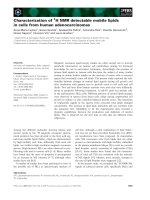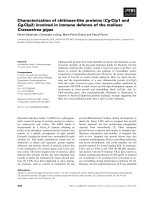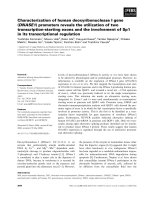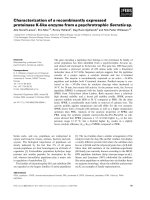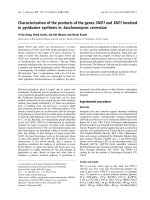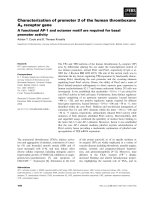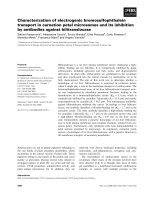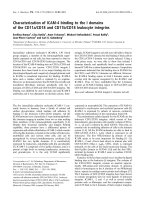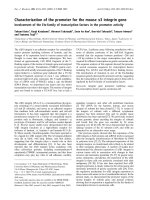báo cáo khoa học: "Characterization of Sucrose transporter alleles and their association with seed yield-related traits in Brassica napus" potx
Bạn đang xem bản rút gọn của tài liệu. Xem và tải ngay bản đầy đủ của tài liệu tại đây (414.43 KB, 47 trang )
This Provisional PDF corresponds to the article as it appeared upon acceptance. Fully formatted
PDF and full text (HTML) versions will be made available soon.
Characterization of Sucrose transporter alleles and their association with seed
yield-related traits in Brassica napus L.
BMC Plant Biology 2011, 11:168 doi:10.1186/1471-2229-11-168
Fupeng Li ()
Chaozhi Ma ()
Xia Wang ()
Changbin Gao ()
Jianfeng Zhang ()
Yuanyuan Wang ()
Na Cong ()
Xinghua Li ()
Jing Wen ()
Bin Yi ()
Jinxiong Shen ()
Jinxing Tu ()
Tingdong Fu ()
ISSN 1471-2229
Article type Research article
Submission date 8 July 2011
Acceptance date 23 November 2011
Publication date 23 November 2011
Article URL />Like all articles in BMC journals, this peer-reviewed article was published immediately upon
acceptance. It can be downloaded, printed and distributed freely for any purposes (see copyright
notice below).
Articles in BMC journals are listed in PubMed and archived at PubMed Central.
For information about publishing your research in BMC journals or any BioMed Central journal, go to
/>BMC Plant Biology
© 2011 Li et al. ; licensee BioMed Central Ltd.
This is an open access article distributed under the terms of the Creative Commons Attribution License ( />which permits unrestricted use, distribution, and reproduction in any medium, provided the original work is properly cited.
1
Characterization of Sucrose transporter alleles and their association with seed
yield–related traits in Brassica napus L.
Fupeng Li, Chaozhi Ma
§
, Xia Wang, Changbin Gao, Jianfeng Zhang, Yuanyuan Wang, Na
Cong, Xinghua Li, Jing Wen, Bin Yi, Jinxiong Shen, Jinxing Tu, Tingdong Fu
National Key Laboratory of Crop Genetic Improvement, National Center of Rapeseed
Improvement in Wuhan, Huazhong Agricultural University, Wuhan 430070, China
§
Corresponding author
Email addresses:
FL:
CM:
XW:
CG:
JZ:
YW:
NC:
XL:
JW:
BY:
JS:
2
JT:
TF:
3
Abstract
Background
Sucrose is the primary photosynthesis product and the principal translocating form within
higher plants. Sucrose transporters (SUC/SUT) play a critical role in phloem loading and
unloading. Photoassimilate transport is a major limiting factor for seed yield. Our previous
research demonstrated that SUT co-localizes with yield-related quantitative trait loci. This
paper reports the isolation of BnA7.SUT1 alleles and their promoters and their association
with yield-related traits.
Results
Two novel BnA7.SUT1 genes were isolated from B. napus lines ‘Eagle’ and ‘S-1300’ and
designated as BnA7.SUT1.a and BnA7.SUT1.b, respectively. The BnA7.SUT1 protein
exhibited typical SUT features and showed high amino acid homology with related species.
Promoters of BnA7.SUT1.a and BnA7.SUT1.b were also isolated and classified as
pBnA7.SUT1.a and pBnA7.SUT1.b, respectively. Four dominant sequence-characterized
amplified region markers were developed to distinguish BnA7.SUT1.a and BnA7.SUT1.b.
The two genes were estimated as alleles with two segregating populations (F
2
and BC
1
)
obtained by crossing ‘3715’ב3769’. BnA7.SUT1 was mapped to the A7 linkage group of the
TN doubled haploid population. In silico analysis of 55 segmental BnA7.SUT1 alleles
resulted three BnA7.SUT1 clusters: pBnA7.SUT1.a- BnA7.SUT1.a (type I), pBnA7.SUT1.b-
BnA7.SUT1.a (type II), and pBnA7.SUT1.b- BnA7.SUT1.b (type III). Association analysis
with a diverse panel of 55 rapeseed lines identified single nucleotide polymorphisms (SNPs)
in promoter and coding domain sequences of BnA7.SUT1 that were significantly associated
with one of three yield-related traits: number of effective first branches (EFB), siliques per
4
plant (SP), and seed weight (n=1000) (TSW) across all four environments examined. SNPs at
other BnA7.SUT1 sites were also significantly associated with at least one of six yield-related
traits: EFB, SP, number of seeds per silique, seed yield per plant, block yield, and TSW.
Expression levels varied over various tissue/organs at the seed-filling stage, and BnA7.SUT1
expression positively correlated with EFB and TSW.
Conclusions
Sequence, mapping, association, and expression analyses collectively showed significant
diversity between the two BnA7.SUT1 alleles, which control some of the phenotypic
variation for branch number and seed weight in B. napus consistent with expression levels.
The associations between allelic variation and yield-related traits may facilitate selection of
better genotypes in breeding.
5
Background
Sucrose is the principal transport form of photosynthetically assimilated carbohydrate in
higher plants. It is synthesized in the source leaf or the pericarp of the pod and transported
via the phloem to sink tissues and provides energy and carbon skeleton to the non-
photosynthetic tissues. In sink tissues, sucrose may be used directly for metabolism or
translocated to storage tissues (such as cotyledon and endosperm) for synthesis of three
major storage products (oil, starch, and protein) through carbohydrate metabolism. On the
basis of these storage products, crops are designated as oleaginous, farinose, or proteinacious
crops [1-4].
Sucrose transporter (SUT) was first reported in spinach (Spinacia oleracea L.)
(Amaranthaceae) [5]. In the last two decades, cDNA for SUTs has been isolated and cloned
in higher plants (e.g., Solanaceae, Brassicaceae, Amaranthaceae, Poaceae) [6-8].
Immunolocalization analysis revealed that SUTs are located in plasma membranes of
enucleate sieve and companion cells [9, 10]. SUTs have been reported to be expressed in
various tissues of the transport pathway and sink cells in Arabidopsis, barley, potato, and
rubber [9-13]. Mutation studies of SUTs have revealed that SUTs are responsible for
restraining plant growth and pollen germination [14-16]. Antisense transformation
experiments have clearly shown that SUTs also are responsible for retardation of sucrose
translocation, fruit size reduction, and lowered fertility in tomato [17, 18]. Overexpression
transformations showed lower sucrose concentration in leaves and increased growth rates of
pea cotyledon [19, 20]. Early stages of seed development in Brassica exhibit a SUT
association with starch and oil accumulation in the embryo; the further growth of the
cotyledon leads to lipid synthesis and starch degradation [2, 21]. Results from another study
6
have suggested that increased lipid synthesis is an effect of sucrose unloading [22]. However,
detailed reports are lacking for SUT in Brassica napus (Brassicaceae).
B. napus is one of the major global oil crops. It is used for direct human consumption,
as animal feed, and recently as a source of bio-fuel. High seed yield per unit is one of the
most important challenges in B. napus breeding, while the harvest index (HI) is only about
0.2–0.3 [23, 24]. Generally, the HI of cereal crops can reach 0.5–0.6 in crop production under
suitable conditions and management, with reserved assimilates in plants contributing 10–
40% of the final yield at the grain filling stage [25]. The HI of soybean, one of the most
important oil crops, also can reach 0.4–0.6 [26, 27] and has been successfully maximized
during breeding [28]. Investigations have indicated that source and sink organs are not
limiting, while assimilate translocation is the most critical limiting factor for seed yield in
Brassica [29, 30]. SUT may be a key gene for increasing seed yield by translocating sucrose
from source to sink.
In our previous investigation, a functional marker derived from SUT was co-localized
with seed yield quantitative trait loci (QTLs) in B. napus [31]. We hypothesized that the SUT
gene affects seed yield in B. napus. Here, a complete SUT (BnA7.SUT1) and promoters were
isolated and characterized. A series of experiments and observations of the B. napus SUT
made it possible to detect alleles located in the A7 linkage group, and allelic variation of
BnA7.SUT1 was associated with seed yield–related traits. BnA7.SUT1.b and its promoter are
linked to higher seed yield, while BnA7.SUT1.a is associated with increased seed weight.
Results
Isolation of BnA7.SUT1
7
Three Brassica fragments (two expressed sequence tagged and a bacterial artificial
chromosome [BAC]; respective GenBank accession numbers AY190281, AY065839, and
AC189334) were obtained from the large-scale sequence analysis results at The Arabidopsis
Information Resource database and identified as having high sequence homology with the
Arabidopsis AtSUC1 (At1G71880) sequence [6]. Primers (M1–M4) were designed based on
conservative segments (see Additional file 1). With these primers, the main genomic
segments of BnX.SUT1 were generated; the remnant fragments and promoter were obtained
by thermal asymmetric interlaced (TAIL) PCR in the B. napus cultivar ‘Eagle’. According to
the contig, the complete open reading frame (ORF) was identified by using gene prediction
programs (GENSCAN; FGENESH), and gene-specific primers were developed to generate
BnX.SUT1 in line ‘S-1300’. Of interest, the PT1 primer pair, which amplifies the 5’-end of
BnX.SUT1, generated the expected band in ‘Eagle’ exclusively (Table 1). Thus, more than 2
kb of promoter and 5’ untranslated region (UTR) were obtained by TAIL-PCR from ‘S-
1300’, respectively. Based on the predicted 5’ and 3’ UTRs of the candidate SUT-like gene,
common gene-specific primers were designed: sut-2L (5'-AGA ATG GGA GCT TTT GAA
ACA G-3') and sut-2R (5'-GGC ATA GAG TAC ACT AAT GGA AG-3'). These primers were
used to amplify the full-length cDNA and genomic sequences of BnX.SUT1. Forty-four
cDNA sequences were isolated from various organs/tissues of ‘Eagle’ and ‘S-1300’ and were
classified into four clusters (Additional file 2). Two clusters showed non-variation sequences
and non-distinguished expression in six B. napus lines (data not shown) and were not
included in further work in this investigation. The other two clusters were designated as
BnA7.SUT1.a and BnA7.SUT1.b, obtained from ‘Eagle’ and ‘S-1300’, respectively.
8
Both putative ORFs of BnA7.SUT1.a and BnA7.SUT1.b contain 1545 bp and encode a
protein of 514 amino acids. The combination of the cDNA and genomic DNA sequences
revealed that the BnA7.SUT1 gene is 2593 bp in length, containing four exons and three
introns. The hydrophobicity profile analysis of BnA7.SUT1 revealed the presence of 12
transmembrane spanning domains, arranged in two sets of six putative transmembrane
domains separated by a long central hydrophilic loop, with both terminal domains and a large
central loop located on the intracellular side of the plasma membrane. BnA7.SUT1 belongs to
the subgroup SUT1 (Additional file 3). The two predicted protein sequences are 98%
identical, having seven amino acid differences between BnA7.SUT1.a and BnA7.SUT1.b
(Figure 1), none of them in transmembrane domains. The cDNA of BnA7.SUT1 shared 76%
sequence identity with a published BnSUT (GenBank accession no. EU570076), which has
508 amino acids. The BnA7.SUT1 sequence is very similar to the homologues from related
species and showed more than 85% sequence similarity with AtSUC1 (AT1G71880) and
BoSUC1 (AY065839) and 81% sequence similarity with AtSUC5 (NM_105847). Hence, the
isolated BnA7.SUT1 alleles, homologous with Arabidopsis and B. oleracea, are novel SUT
genes in B. napus.
Nucleotide sequence analysis
Seventeen primer pairs were designed to generate fragments of about 400 bp to 1700 bp. Ten
primer pairs were designed from the sequences of BnA7.SUT1.a and seven from the diverse
domains of BnA7.SUT1.b. Four markers (Table 1, Figure 1) showed polymorphisms between
‘Eagle’ and ‘S-1300’. ET3 and PT1, which were developed from BnA7.SUT1.a and its
promoter, generated the expected fragments in ‘Eagle’ but not in ‘S-1300’. By contrast, ET4
9
and PT5, amplifying BnA7.SUT1.b and its promoter, generated the expected bands in ‘S-
1300’ exclusively (Figure 1). The four sequence-characterized amplified region (SCAR)
markers were used to analyze the 55 cultivars/lines. And the panel lines were distinguished as
three groups by these markers.
The 55 partial BnA7.SUT1 genomic fragments of ~1570 bp were amplified from the
panel lines using primer pairs PT1-L/PT1-R and PT5-L/PT1-R (Figure 1), which are located
382 bp upstream and 1191 bp downstream from the start codon of BnA7.SUT1. In total, 142
single nucleotide polymorphism (SNP) sites were detected among the lines, including 120
SNPs in the promoter and 5’-UTR, 12 SNPs in exons, and 10 in introns. The genetic diversity
between two regions was analyzed according to distinct different diversities in the 5’-end and
gene regions. Nucleotide diversity was lower in gene regions (π=0.00534) compared with 5’-
end regions (π=0.13502). Tajima’s D of gene regions indicated non-significance, while the
5’-end of BnA7.SUT1 had a positive and significant Tajima’s D value (Table 2). The results
indicated that selection was present at the 5’-end and that the selection effect had not
extended to the entire gene.
Linkage disequilibrium (LD) was estimated between 51 pairs of polymorphic sites
(SNPs and indels) in the BnA7.SUT1 sequence; two LD blocks were observed at the 5’-end
and gene regions, respectively (Figure 2). Abundant SNPs resulted in the same haplotypes
among the lines, which could be classified into three clusters consistent with the results of the
neighbor-joining distance tree (Additional file 4). Overall, we found interesting results
indicating that the BnA7.SUT1.a promoter regulates only BnA7.SUT1.a and that the
BnA7.SUT1.b promoter regulates both BnA7.SUT1.a and BnA7.SUT1.b, designated as
pBnA7.SUT1.a- BnA7.SUT1.a (type I), pBnA7.SUT1.b- BnA7.SUT1.a (type II), and
10
pBnA7.SUT1.b- BnA7.SUT1.b (type III). Nucleotide diversity was also separately evaluated
for type I, type II, and type III based on 382-bp sequences of the 5’-end (Table 2). Type III
and type I presented no polymorphisms and one indel (s330) among 18 and 16 lines,
respectively. However, type II showed one SNP (s95) and three indels (s98, s229, and s330)
among 21 lines (Figure 3).
Allelism analysis and genetic mapping
To identify the allelism of BnA7.SUT1.a and BnA7.SUT1.b, ‘3715’ (type III) and ‘3769’ (type
I) were used to develop F
1
, F
2
, and BC
1
populations. With these populations, segregation
ratios were analyzed using the markers PT1 and PT5. The segregation of heterozygous F
1
plants to single-band plants in the F
2
population showed the expected Mendelian ratio of
1:2:1 (number of plants was 45:119:61) (χ
2
=3.03, 0.10<P<0.25), and the expected ratio of 1:1
(number of plants was 46:49) in the BC
1
population (χ
2
=0.074, 0.75<P<0.90). Therefore,
BnA7.SUT1.a and BnA7.SUT1.b appeared to be alleles at a single locus.
BnA7.SUT1 showed high similarity with the BAC (
AC189334) from B. rapa, and three
simple sequence repeats (SSR) markers were developed according to the BAC sequence.
Additionally, gene-specific primers were designed based on BnA7.SUT1.b. An SSR marker
(sRsut1) and a gene-specific marker (lo-sut1) showed the same polymorphisms found in the
‘Tapidor-NY7’ (TN) doubled haploid (DH) population. Hence, BnA7.SUT1 was mapped to
the A7 linkage group of the TN DH genetic map (Figure 4), consistent with result of Li et al.
[31].
Association of BnA7.SUT1 with yield-related traits
11
The mean phenotypic values for individual lines across four environments ranged from 4.1 to
9.8 for the number of effective first branches (EFB); 111.6 to 312.2 for the number of siliques
per plant (SP); 11.5 to 32.5 for the number of seeds per siliques (SS); 5.0 to 19.5 g for seed
yield per plant (PY); 174.0 to 842.1 g for block yield (BY); and 2.2 to 5.4 g for seed weight
(TSW) (n=1000), respectively. Analysis of variance showed significant (P=0.01) phenotypic
variation for all six yield-related traits among the 55 lines (Table 3), indicating that the
assembled panel is suitable for association analysis. Heritabilities were 83.7%, 82.4%,
91.4%, 62.6%, 78.7.6%, and 95.1% for EFB, SP, SS, PY, BY, and TSW, respectively (Table
3). Significant positive phenotypic and genetic correlations between EFB and SP and
between yield and silique traits (SP and SS) were observed (Table 3), indicating that an
increase in any of the EFB, SP, or SS traits can increase seed yield.
The panel lines evaluated for yield-related traits were mostly modern cultivars and
breeding materials. There were considerable differences among the panel lines according to
UPGMA cluster (Additional file 5). Population structure was observed among the 55
cultivars/lines based on the method by Hasan et al. [32].The slope of average likelihoods for
the overall population was modeled at K=4 (Figure 5); the most stable prediction (standard
deviation=1.99) was obtained with four groups. Each group consisted of 18, 16, 16, and 5
oilseed lines, respectively. Taking the LD (r
2
>0.8) level among sites into account and
eliminating same-haplotype SNPs, five sites were significantly associated with at least one of
the six yield-related traits (P<0.05). Information including location, genotype, frequency, and
probability value for each site is shown in Table 4. Of interest, the SNP sites (s60 and s222)
from the promoter and s1448 from the exon of BnA7.SUT1 were associated with EFB and
TSW and explained an average 12% and 11% of phenotypic variation throughout the four
12
environments, respectively. The s222 SNP at the promoter in turn affected SP (Table 4).
Phenotypic distributions of the previous four yield-related traits are illustrated in three
genotypes by box-plots in Figure 6. Promoter BnA7.SUT1.b was associated with an increased
EFB number and SP number. For TSW, no significant differences were observed between
type I and type II with BnA7.SUT1.a. However, a significant difference was observed
between type I and type III and between type II and type III with different BnA7.SUT1
alleles. Hence, polymorphisms at the promoter and coding domain sequence (CDS) of
BnA7.SUT1 affect yield-related traits interactively.
Expression pattern analysis by real-time PCR
Spatial and developmental expression profiling of BnA7.SUT1 was performed using real-time
PCR on all three genotypes, type I, type II, and type III, to extract RNA from different
organs/tissues at the seed-filling stage. BnA7.SUT1 mRNA showed a higher expression level
in vegetative organs, reaching its highest level in stems and leaf blades (Figure 7A). Greater
abundance was detected in stems of type II and type III genotypes, indicating that the effect
of the BnA7.SUT1.b promoter was stronger than BnA7.SUT1.a promoter in stems. On the
other hand, BnA7.SUT1 showed lower expression levels in reproductive organs. In flower
buds, BnA7.SUT1 showed similar transcript levels in all three genotypes.
When pods reached 25 days after flowing (DAF), transcription of BnA7.SUT1 showed
variations in pods, pericarp, and young seeds in different genotypes. Higher abundance was
detected in pods and pericarp of type III genotypes and in developing seeds of type I
genotypes. The expression level of BnA7.SUT1.b was 3-fold higher than that of BnA7.SUT1.a
in pods, and 10-fold higher in pericarp. However, the expression of BnA7.SUT1.b decreased
13
by three times in developing seeds as compared to BnA7.SUT1.a, which showed that
BnA7.SUT1.b accumulated at higher levels in pods and pericarp, while BnA7.SUT1.a
produced higher expression levels when regulated by the promoter of BnA7.SUT1.a (Figure
7A). Different alleles of BnA7.SUT1 also exhibited diverse expression levels when regulated
by the same promoter of BnA7.SUT1.b, indicating that alleles of BnA7.SUT1 also present
different gene expression patterns.
In different developmental phases, source leaves were sampled 100 days after sowing
(DAS) initially, then at monthly intervals. The abundance of the BnA7.SUT1 transcript
declined to a low level at flowering. As pods matured, the expression of BnA7.SUT1 again
showed increased expression levels (Figure 7B). In the developing pods, BnA7.SUT1 was
highly expressed in the pistil when pods were rapidly elongating and remained at a relatively
high level at 3 DAF and 12 DAF. However, expression decreased to a low level at 25 DAF,
when the dry weight of pods reached the maximum (Figure 7C).
Discussion
Isolation and genetic variations of BnA7.SUT1
Our current research describes the isolation of a novel SUT gene BnA7.SUT1 and its two
alleles BnA7.SUT1.a and BnA7.SUT1.b in B. napus. The cDNAs of BnA7.SUT1.a and
BnA7.SUT1.b showed 18 polymorphic sites and variations in seven amino acids, none of
which are located in the SUT transmembrane. The predicted proteins showed similarity with
all the other SUTs in amino acid sequence and protein secondary structures with histidine
residue position 65 [6, 33]. A higher similarity of BnA7.SUT1 with other functional SUTs
indicated that BnA7.SUT1 proteins may play an important role in sucrose transport.
14
We observed frequent sequence exchanges in BnA7.SUT1 that resulted in generation of
two alleles of BnA7.SUT1. Gene conversion and unequal crossing-over are important in
generating variation at gene sequences, and recombination events produce novel genotypes
[34]. Sequence analysis of 55 B. napus lines showed that the BnA7.SUT1 gene could be
classified into three genotypes. The type III genotype showed 98% genomic sequence
similarity with the type II genotype. The polymorphisms were located in the 5’UTR, and
there was a 3-bp indel polymorphism at position 229–231 between the type I and type III
genotypes; the type II genotype contained either polymorphism. Upstream of the indel, type
II and type III genotypes showed the same polymorphisms among the three genotypes; in
contrast, downstream of the indel, type I and type II presented the same polymorphisms.
Hence, we hypothesized that type II is the result of rearrangements between type I and type
III, although this hypothesis requires further molecular evidence. Newly generated chimeras
were selected and maintained in a population; however, the BnA7.SUT1.a- BnA7.SUT1.b
genotype could not be found in association with the promoter of BnA7.SUT1.a and may have
been selected against during the breeding process. Similar recombination of HvFT1 (barley)
has generated various alleles [35], which support our findings. The Zep allele was generated
as a result of recombination with different promoters and regulated the expression level of
Zep [36].
Association between BnA7.SUT1 and yield-related traits
SUTs drive translocation of sucrose and in turn affect seed yield and fruit size [18, 37]. In
another study carried out in our laboratory, identification of yield-related QTLs in a B. napus
functional map [38] indicated that a functional marker from SUT in the A7 linkage group was
15
related to EFB, SP, and TSW in the A7 linkage group [31, 39]. Here, we report likely
polymorphisms in BnA7.SUT1 associated with yield-related traits, and allelic variation at the
promoter and CDS of BnA7.SUT1 correlated with expression pattern and phenotype.
Polymorphisms at the promoter and CDS regions with an effect on expression abundance are
likely candidates for causative QTPs [40, 41]. Similarly, allelic polymorphism at the
promoter and intron of HvFT1 in barley contribute to variation in flowering time [35].
SUTs have three types of clades designated as protype SUT1 (clade I), SUT2 (clade
II), and SUT4 (clade III) [38, 42-44], and BnA7.SUT1 falls into the protype SUT1 (clade I).
Generally, SUT1 mRNA and protein, notably OsSUT1, AtSUC2, and StSUT1, are present in
mature phloem and primarily involved in phloem loading. The rice SUT, OsSUT1, plays a
significant role in sucrose transport in developing shoots and roots, which is a decisive factor
for seed germination and early seedling growth [42]. AtSUC1 also has a role in vegetative
growth and for normal gametophyte functioning [16]. In higher plants, sugars and hormones
interact and form an intricate regulatory sensing and signaling network [45], and altered
sucrose levels can change the quantity of sucrose-derived metabolites and sucrose-specific
signaling [46]. In the current work, BnA7.SUT1 showed higher expression levels in the stem
of type II and type III genotypes, consistent with increased EFB. These results indicated that
blocking translocation of sucrose at the stem influences either carbon abundance for
metabolism or signals.
Oilseed plants with lush branches and leaves, in contrast, produce many empty pods
and shrunken seeds at maturity, resulting from insufficient import to the developing seeds
[47]. Breeding experiences indicated that translocation of carbohydrate assimilate from
source to sink is a major constraint on seed yield [29, 48]. The lower expression of
16
BnA7.SUT1 in type I genotypes resulted in the lowest yield in the three genotype lines,
suggested that retardation of photoassimilate translocation leads to decreased yield. At the
pod-filling stage, most leaves abscise and the pod remains primarily a photosynthetic organ
[49]. The volume of the pod is estimated at 20 DAF, and the dry weight of the pod reaches a
maximum at 25 DAF when sucrose is stored in the pericarp for the later period of seed
development[48]. The lower expression observed here of BnA7.SUT1 in the pod and
developing seed suggests an effective role in the photoassimilate unloading process.
BnA7.SUT1 showed a reduced expression trend as the pod reached maximum weight (25
DAF). The low expression level of BnA7.SUT1 in the pod may be the result of the failure of
transportation of sucrose in the developing seed. In our investigation, seed weight was
negatively correlated with seed yield. Plants with fewer branches and siliques could
distribute more storage substance into each seed with a resulting larger seed weight,
indicating that ‘sink’ is sufficient in general oilseed plants. ‘Source’ is also not the limitation
for seed yield in oilseed [29, 30]. Therefore, ‘flow’ is the most important factor and controls
seed yield. Our results support this reasoning. The promoter BnA7.SUT1.b correlation with
increasing EFB number may be a potential resource for breeding.
Some key genes are closely correlated with yield-related traits. Of great interest,
application of dwarfing genes caused a green revolution in the 1960s and doubled grain
production only in 40 years [50-52]. On the other hand, most phenotypic variation of
agronomic traits is continuous and remarkably influenced by different alleles. In tomato,
alleles of fw2.2 result in fruit size variation up to 30% and appear to have been responsible
for a key transition during domestication [53]. Plant architecture is very important for
improving yield traits; tb1 acts as a major contributor to apical dominance in maize and
17
regulates lateral branching in rice [54, 55]. Moreover, GS3 and Ghd7 show significant effects
on grain size and multiple yield-related traits in rice, respectively [56, 57]. Thus,
characterization and application of crucial genes/alleles may be an effective means of
improving yield. Our investigation indicated that SUT may play an important role in sucrose
translocation and affect seed yield in B. napus. Investigations with larger and/or natural sets
of B. napus are necessary to validate the association. Furthermore, alteration of sucrose
concentration will provide convincing evidence. However, the current characterization of
allelic variation and association with yield may be a potential basis for breeding.
Conclusions
Previous QTL analysis of seed yield–related trait associations with functional markers
showed that SUT was located in the QTL interval associated with branch number and seed
weight. In this study, we isolated different alleles of BnA7.SUT1 and identified three
genotypes. Lines with the BnA7.SUT1.b promoter exhibited better seed yield–related traits.
At the pod development phase, BnA7.SUT1 showed an increased expression level and a
decreasing trend with increasing seed weight. These results indicate reduced transport of
photoassimilate from source to sink. BnA7.SUT1 may play an important role in
photoassimilate accumulation and storage, in turn affecting seed yield.
Methods
Plant materials
Two B. napus lines ‘S-1300’ and ‘Eagle’, showing variation in vegetative and reproductive
traits, were grown under field conditions and used to isolate BnX.SUT1. ‘S-1300’ is a Chinese
18
semi-winter self-incompatible line, and ‘Eagle’ is a Swedish spring line. A panel of 55 semi-
winter B. napus cultivars/lines maintained at Huazhong Agricultural University, Wuhan,
PRC, were used for association in this study. F
1
, F
2
, and BC
1
populations, resulting from the
cross ‘3715’ב3769’, were employed for allelism analysis. The TN DH population, resulting
from a cross between ‘Tapidor’ and ‘NY7’ [58], served for mapping BnA7.SUT1. Marker-
differentiated cultivars/lines were planted during 2008–2010 at Huazhong Agricultural
University. Their leaves, shoots, flower buds, pods, pericarps of pods, and young seeds at the
filling stage (20 DAF), leaves, and pods at different developmental stages were used for
expression analysis by real-time PCR.
Field experiments and trait measurements
The experiments were conducted in three locations (Wuhan, Huanggang, Yichang) in Hubei
Province, China. Fifty-five B. napus cultivars/lines were grown for two consecutive growing
seasons during 2007/08 and 2008/09 at Huazhong Agricultural University, Wuhan, China;
they were also grown at the local Academy of Agricultural Science sites in Yichang and
Huanggang during 2008/09. Rapeseed plots were subsequently followed by rice crops in all
experimental fields. All trials were designed as randomized blocks with three replications in
each environment. Each plot consisted of three rows, 3.5 m length with 0.25 m distance
between rows. Seeds were sown between the last 5 days of September and the first 5 days of
October with the distance between plants in each row reduced to 0.15 cm at 40 days post-
emergence. All trials were managed following normal, standard agricultural practices.
At maturity, 12 plants in the middle row were randomly harvested from each plot for
evaluation of the following quantitative traits: number of EFB, number of SP, number of SS,
19
TSW, and seed YP. Residual plants of each block were harvested and used to determine BY
(Additional file 6).
DNA extraction and genetic mapping of BnA7.SUT1
Genomic DNA of the planted materials, including parents, segregating population, and the
panel of 55 cultivars/lines, was extracted from young leaves according to CTAB
methodology [59], and DNA from three individuals in each variety/line was mixed for PCR
analysis. Based on sequences of the BAC (
AC189334) and BnA7.SUT1, the SSR marker and
gene-specific primers were designed and used to map the gene in the TN DH population
using JoinMap 3.0 (
Sequencing and analysis
Promoter and partial CDS regions of BnA7.SUT1 were generated using primer pairs as
follows: PT1-L/PT1-R and PT5-L/PT1-R. PCR was performed in reaction volumes of 20 µL
containing the following: 50 ng genomic DNA, 1 unit Taq polymerase (MBI Fermentas,
Lithuania), 2 µL 10×Taq buffer with (NH
4
)
2
SO
4
, 2 mM MgCl
2
, 0.2 mM dNTP mix (Sangon,
China), and 0.5 µM of each primer. PCR conditions were initial denaturation for 4 min at
94°C, 30 cycles of 45 s at 94°C, annealing at 60°C for 45 s, and extension for 60 s at 72°C,
followed by an extension of 10 min at 72°C. PCR products were separated by 1.2% agarose
gel electrophoresis and detected by staining with ethidium bromide. The PCR products were
purified using the Gel Purification Kit (Sago, Shanghai, China) and ligated into the pMD18-T
vector (TaKaRa, Japan). Positive transformed clones were selected for sequencing. The
fragments were analyzed using the SEQMAN application of the DNASTAR software suite
20
(Windows version 5.0.2; DNASTAR, Madison, WI, USA) and aligned in MEGA 4.0 [60].
Singletons, which occurred only once as polymorphisms among the sequenced materials,
were analyzed until they were confirmed as correct. The LD level between sites and Tajima’s
D statistic were calculated using TASSEL 2.1[61].
Population structure and statistical analyses
The AFLP technique, following the protocol of Vos et al. [62] with minor modifications by
Lu et al. [63], was employed to genotype the 55 breeding lines. AFLP primers amplify
different marker alleles at multiple loci in the allotetraploid B. napus genome. It is difficult or
impossible to assign the different marker alleles to individual loci in genotypes with high
allelic diversity. All AFLP alleles were scored as present or absent in each genotype. In total,
139 polymorphisms were obtained with restriction enzymes PstI/MseI. Subsequently, the
data were used to infer the population structure (Q) with the model-based Bayesian clustering
approach in the software STRUCTURE 2.2 [64]. The membership coefficients were
calculated as 10 independent runs for each k (set from 1 to 10) with a burn-in of 50,000
iterations followed by 50,000 interactions. A summary of the average of data likelihoods
(LnP(D)) is shown in Additional file 7.
Mean values, variance components of each yield-related trait, heritability, and
correlation coefficients were calculated, respectively. Variance components were computed
for lines, environments, interaction between lines and environments, and error. Broad-sense
heritability was estimated according to the formula h
2
= σ
2
g
/ (σ
2
g
+σ
2
gl
/n + σ
2
e
/nr), whereσ
2
g
is
the genotypic variance, σ
2
gl
is the interactional variance of genotype and environment, σ
2
e
is
21
the error variance, r is the number of replicates of each environment, and n is the number of
environments [65].
Associations between polymorphism sites and yield-related traits were implemented
using general linear model analysis in the software package TASSEL 2.1 [61]. The Q matrix
was used as the covariate in the analysis to control the population structure. All
polymorphisms were tested, and P values for individual polymorphisms were estimated
based on 10,000 permutations. The rescaled P value accounts for the proportion of the
random marker with a permuted P value less than or equal to 0.05. Data from each test
environment were calculated independently.
RNA extraction and real-time PCR
Total RNAs were extracted from respective tissues using Tripure reagent (Bioteke,
Subsequently, the cDNAs were synthesized with M-MLV
reverse transcriptase and an oligo (dT) primer (Fermentas, USA) in a 20 µL volume
according to the manufacturer’s instructions. The resultant first strand cDNA mixture was
diluted with sterile distilled water and used as a template for PCR and for real-time PCR.
Real-time quantitative PCR was performed using the SYBR Green Realtime PCR Master
Mix (TOYOBO, Osaka, Japan). The PCR reactions contained 400 nM of both forward and
reverse gene-specific primers and 8.4 µL of the 50-fold diluted reverse transcriptase (RT)
reaction in a final volume of 20 µL. The thermal cycling protocol was followed by DNA
polymerase activation at 95°C for 3 min. The PCR amplification was carried out with 45
cycles of denaturation at 95°C for 10 s, primer annealing at 60°C for 15 s, and extension at
72°C for 30 s. Optical data were acquired following the extension step, and the PCR
22
reactions were subject to melting curve analysis beginning at 65°C through 95°C, at 0.1°C s
-
1
. The amplified products were sequenced to ensure that each primer pair amplified one
specific gene. The data are presented as an average±SD of three independently produced RT
preparations used for PCR runs, each having four replicates. The relative expression levels
were calculated using the 2
-△△C
T
method [66].
Author contributions
FL designed and carried out the linkage, association, and expression analyses and wrote the
initial draft of the manuscript. CM conceived of and supervised the overall research. XW
participated in the sequence amplification and alignment. CG, JZ, YW, and NC participated
in field experimentation. XL implemented field management. JW, BY, JS, JT, and TF helped
draft the manuscript. All authors have read and approved the final manuscript.
Acknowledgements
We are grateful to several anonymous reviewers for helpful suggestions in revising the
manuscript. We thank Professor Jinling Meng (National Key Laboratory of Crop Genetic
Improvement, Huazhong Agricultural University, Wuhan, China) for providing the TN DH
population derived from the cross Tapidor×Ningyou7. We gratefully acknowledge the efforts
of Associate Professor Duane Falk of the University of Guelph and Gautam Mayank for
reading and editing the English version of the manuscript. This work was financially
supported by the State Key Basic Research and Development Plan of China
(2007CB109001) and Hi-Tech Research and Development Programs of China
(2011AA10A104) and by the National Science Foundation of China (30971802).
23
References
1. Weselake RJ: Storage Product Metabolism in Microspore-Derived Cultures of
Brassicaceae. Biotech Agric For 2005, 56:97-122.
2. Rawsthorne S: Carbon flux and fatty acid synthesis in plants. Prog Lipid Res 2002,
41(2):182-196.
3. Hill LM, Morley-Smith ER, Rawsthorne S: Metabolism of sugars in the endosperm
of developing seeds of oilseed rape. Plant Physiol 2003, 131(1):228-236.
4. Rae AL, Perroux JM, Grof CP: Sucrose partitioning between vascular bundles and
storage parenchyma in the sugarcane stem: a potential role for the ShSUT1
sucrose transporter. Planta 2005, 220(6):817-825.
5. Riesmeier JW, Willmitzer L, Frommer WB: Isolation and characterization of a
sucrose carrier cDNA from spinach by functional expression in yeast. EMBO J
1992, 11(13):4705-4713.
6. Sauer N, Stolz J: SUC1 and SUC2: two sucrose transporters from Arabidopsis
thaliana; expression and characterization in baker's yeast and identification of
the histidine-tagged protein. Plant J 1994, 6(1):67-77.
7. Barker L, Kühn C, Weise A, Schulz A, Gebhardt C, Hirner B, Hellmann H, Schulze
W, Ward JM, Frommer WB: SUT2, a putative sucrose sensor in sieve elements.
Plant Cell 2000, 12(7):1153-1164.
8. Aoki N, Whitfeld P, Hoeren F, Scofield G, Newell K, Patrick J, Offler CE, Clarke B,
Rahman S, Furbank RT: Three sucrose transporter genes are expressed in the
developing grain of hexaploid wheat. Plant Mol Biol 2002, 50:453-462.
24
9. Sauer N, Ludwig A, Knoblauch A, Rothe P, Gahrtz M, Klebl F: AtSUC8 and AtSUC9
encode functional sucrose transporters, but the closely related AtSUC6 and
AtSUC7 genes encode aberrant proteins in different Arabidopsis ecotypes. Plant J
2004, 40(1):120-130.
10. Sivitz AB, Reinders A, Ward JM: Analysis of the Transport Activity of Barley
Sucrose Transporter HvSUT1. Plant Cell Physiol 2005, 46:1666-1673.
11. Liesche J, Schulz A, Krugel U, Grimm B, Kühn, C: Dimerization and endocytosis
of the sucrose transporter StSUT1 in mature sieve elements. Plant Signal Behav
2008, 3(12):1136-1137.
12. Tang CR, Huang DB, Yang JH, Liu SJ, Sakr S, Li HP, Zhou YH, Qin YX: The
sucrose transporter HbSUT3 plays an active role in sucrose loading to laticifer
and rubber productivity in exploited trees of Hevea brasiliensis (para rubber
tree). Plant Cell Environ 2010, 33(10):1708-1720.
13. Aoki N, Scofield GN, Wang XD, Patrick JW, Offler CE, Furbank RT: Expression
and localisation analysis of the wheat sucrose transporter TaSUT1 in vegetative
tissues. Planta 2004, 219(1):176-184.
14. Gottwald JR, Krysan PJ, Young JC, Evert RF, Sussman MR: Genetic evidence for
the in planta role of phloem-specific plasma membrane sucrose transporters.
Proc Natl Acad Sci USA 2000, 97(25):13979-13984.
15. Srivastava AC, Dasgupta K, Ajieren E, Costilla G, McGarry RC, Ayre BG:
Arabidopsis plants harbouring a mutation in AtSUC2, encoding the predominant
sucrose/proton symporter necessary for efficient phloem transport, are able to
complete their life cycle and produce viable seed. Ann Bot 2009, 104(6):1121-1128.
